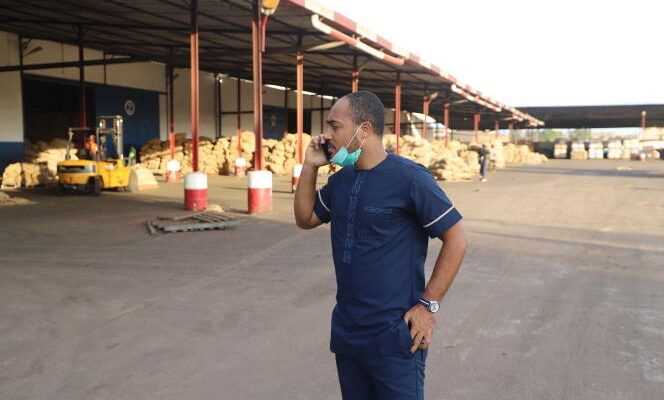At the end of a winding road, the future San Pedro stadium appears like a mirage. It marks the end of the “Coastal”, this chaotic road linking Abidjan, the Ivorian economic capital, to San Pedro, the largest cocoa port in the world. The stadium, with a capacity of 20,000 seats, will host matches of the African Cup of Nations football (CAN) from June 2023. This implies, by then, the repair of more than 300 km of national road now damaged.
The host city was not chosen at random: after Abidjan, San Pedro is the second economic heart of the country, fueled by the activity of its port. At the entrance of one of the port terminals, the backhoe loaders nibble the cumbersome reliefs of the area. “It has become too small here, they will raze all the trees and dynamite the hill”, warns Ivorian-Lebanese entrepreneur Samir Lakiss, deputy director of the Société Agricole de Café Cocoa (SACC), one of the ten largest cocoa exporting companies in the country, which employs 1,500 people.
We must make room to satisfy great ambitions: to multiply by fifteen the volume of goods (5 million tons per year at present) by 2035. Admittedly, the activity of these last months has slowed down, as a result of the Covid-19 epidemic. But Samir Lakiss is very optimistic about his business and his city: “The port is expanding, it will generate jobs and relieve Abidjan’s congestion. San Pedro is the next Ivorian El Dorado. “
“Brown gold” and “resourcefulness”
While the Ivorian coast is generally neglected because of the lamentable state of the Coast, San Pedro is an exception. Built from 1968 onwards, the port gradually increased in power, eventually surpassing that of Sassandra. Its activity exploded after the post-election crisis of 2010-2011, driven by the annual export of hundreds of thousands of tonnes of cocoa beans produced in the southwest of the country. “Brown gold” today generates 15% of Ivorian GDP. And brings work to millions of people.
Gaoussou Paré is one of them. “The extension of the port will pay off. And not only in cocoa! Many companies will come to export wood, rubber, cotton, nickel ”, lists this docker of Burkinabe origin. “When I work, I earn 9,000 CFA francs per day [près de 14 euros], that’s twice as much as before. And when there is no work, I still have a salary of 3,500 CFA francs “, he explains on the steps of his small cafe located opposite the port – an activity that provides him with additional income. “We are “unscramblers”. Everyone is doing their own thing ”, he continues.
It is thanks to this “Get by” that Gaoussou Paré was able to move from the Bardot district, long considered the largest slum in West Africa. In 2011, electrification and sanitation works gave new hope to the inhabitants. But it did not last. “When I come back to it, I tell myself that development has not arrived so far”, regrets the docker as he walks through the dirt lanes strewn with garbage where he lived for twelve years. “I have traveled a lot in the region, but it is the poorest place that I have seen, he says. San Pedro is the second Ivorian city economically? Once on the ground, you see that this is not the case everywhere. There is still no water here. “
Water carriers crisscross the alleys of the slum to supply the populations. “We have taps but the water is not flowing”, points out Blandine, manager of a small maquis. And the rains generate impressive floods, traces of which are still visible on the sparse wooden houses. “It can go up to 40 centimeters”, says Gaoussou Paré.
“I did not become a choco”
In Bardot, the inhabitants are mainly Burkinabés who have come to seek employment in an attractive city. In the old district of Gaoussou Paré, men work on an interim basis and, on non-working days, meet in the maquis around the “Tchapalo”, artisanal millet beer from Burkina Faso. “When you are Burkinabe, you stay in your corner. You cannot criticize, otherwise we tell you to go home », remark the docker.
Gaoussou Paré now lives in a slightly cleaner and more secure area, on the outskirts of Bardot. A not very big house, but built in solid this time. “Be careful, I did not become a choco [chic], it remains a neighboring district, he recalls. But here we have water, electricity, a school and a mosque nearby. It’s better for children. “
If Gaoussou Paré’s life is slowly improving, the gap between him and the wealthy entrepreneurs of the industrial zone of San Pedro remains immense. Near the port, on the hills overlooking the seafront, imposing and luxurious houses have emerged from the earth. The big names in cocoa and a few ministers have residences there with breathtaking views of the Atlantic.
And hotel groups are snapping up the remaining places. The reopening of San Pedro airport in 2018 boosted tourism to the beaches of Grand-Béréby, 50 km further west, known to turtle enthusiasts, who come to lay there at the end of the year. A sign that with a road and a few investments, medium-sized coastal towns can also take off.
Summary of the series “La Côtière, route de tous les galères”
